Balance sheets of the Fed, ECB, BOJ, BOE, and central banks of China, Canada, Australia, Switzerland, and India as % of GDP.
By Wolf Richter for WOLF STREET.
The major central banks around the world have been unwinding their balance sheets for the past few years, even the Bank of Japan, which got a late start in 2024. Their balance sheets had swollen to grotesque proportions during the global QE frenzy that started in 2008, and QE-mania during and after the pandemic. But that has been getting unwound.
The Bank for International Settlements (BIS), an umbrella organization owned by its member central banks, released its latest quarterly data on central bank balance sheets today. We’ll look at the decline of the balance sheets of nine major central banks: Federal Reserve, European Central Bank, Bank of Japan, People’s Bank of China, Bank of England, Central Bank of India, Bank of Canada, Reserve Bank of Australia, and the Swiss National Bank.
In normal times, central-bank balance sheets, including the Fed’s balance sheet, grew with the economy, as measured by GDP; and the ratio of total assets as a percentage of GDP back then was low and roughly stable over the years. Years of QE then caused the ratios to explode. And years of QT have now caused the ratios to shrink dramatically.
The ratio of total assets (in local currency) to GDP (in local currency) allows us to compare the relative size of the balance sheets of different central banks. The ratio eliminates issues associated with exchange-rate fluctuations (since the underlying data is in local currency) and inflation (since the inflation factors are both in the numerator and in the denominator and thereby cancel each other out).
Federal Reserve chair Powell talked about this ratio at the last press conference to demonstrate by how much the Fed’s three-plus years of QT has shrunk the balance sheet. Even if the balance sheet remains flat going forward, while the economy grows, the ratio will continue to shrink – a soft form of QT. I’ve been discussing this ratio for over a year, most recently in my Fed balance sheet analysis for October.
By October, the Fed’s QT had shed $2.4 trillion in assets, and the assets-to-GDP ratio dropped to 21.6%, where it had first been in Q3 2013:
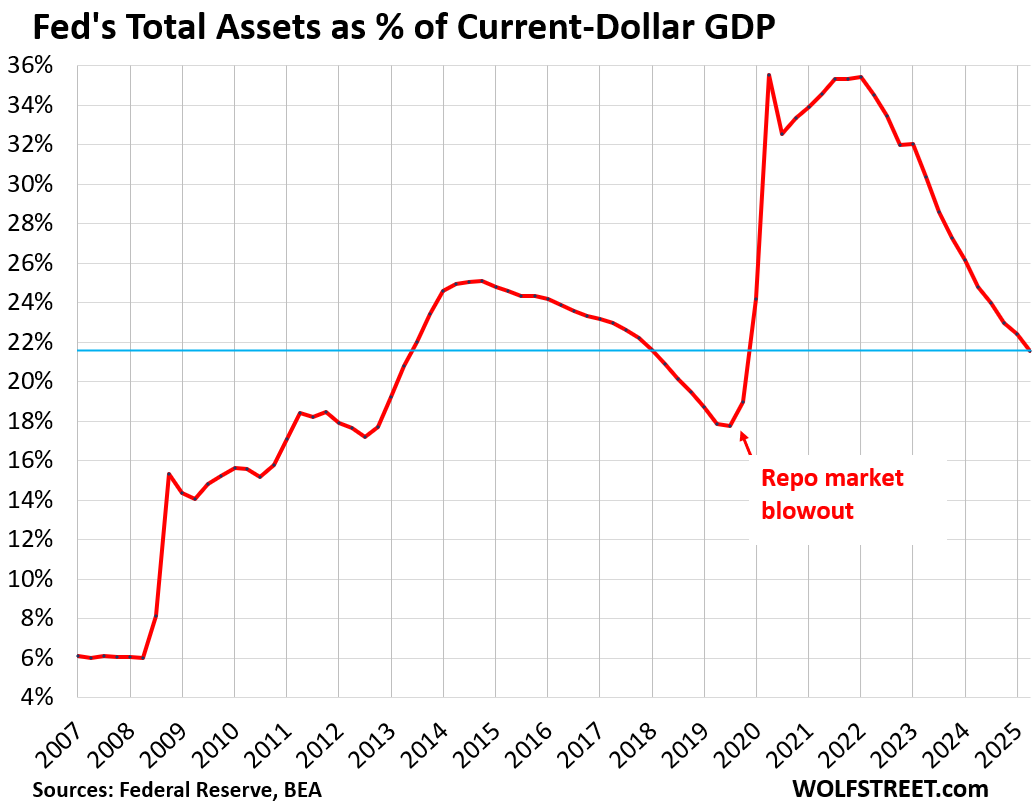
The European Central Bank shed €3.3 trillion ($3.8 trillion) of its QE assets, and QT continues at the pace that was accelerated for 2025. Here is my detailed discussion of the ECB’s balance sheet through Q3, including its gold holdings which are marked to market quarterly.
The ECB’s total-asset-to-GDP ratio has dropped to 39.5%, according to BIS data today. While this removed the entire pandemic QE spike, and is way down from the crazed money-printing peak in Q4 2021 when the ratio had hit 68%, it remains very high. (By comparison, the Fed’s assets-to-GDP ratio had maxed out at just under 36% in early 2022 and is now at 21.6%.)

The Bank of Japan is in a category of its own, along with the Swiss National Bank (SNB), in terms of money printing craziness. But even it flipped to QT in early 2024, and has since then accelerated the pace. At the end of the quarter through September, total assets had fallen by ¥61.2 trillion ($407 billion), or by 8.1%, back to where they’d first been at the end of 2020. My discussion of the details of the BOJ’s balance sheet is here.
The BOJ’s assets-to-GDP ratio dwarfs the ratios of the other central banks, except for the SNB’s. At the peaks in Q1 2021 and Q1 2022, the ratio had hit 132.7%, nearly double the ECB’s crazed money-printing peak ratio of 68%, and nearly four times the Fed’s money-printing peak ratio of 36%.
The ratio has now dropped to a still gigantic 115%:
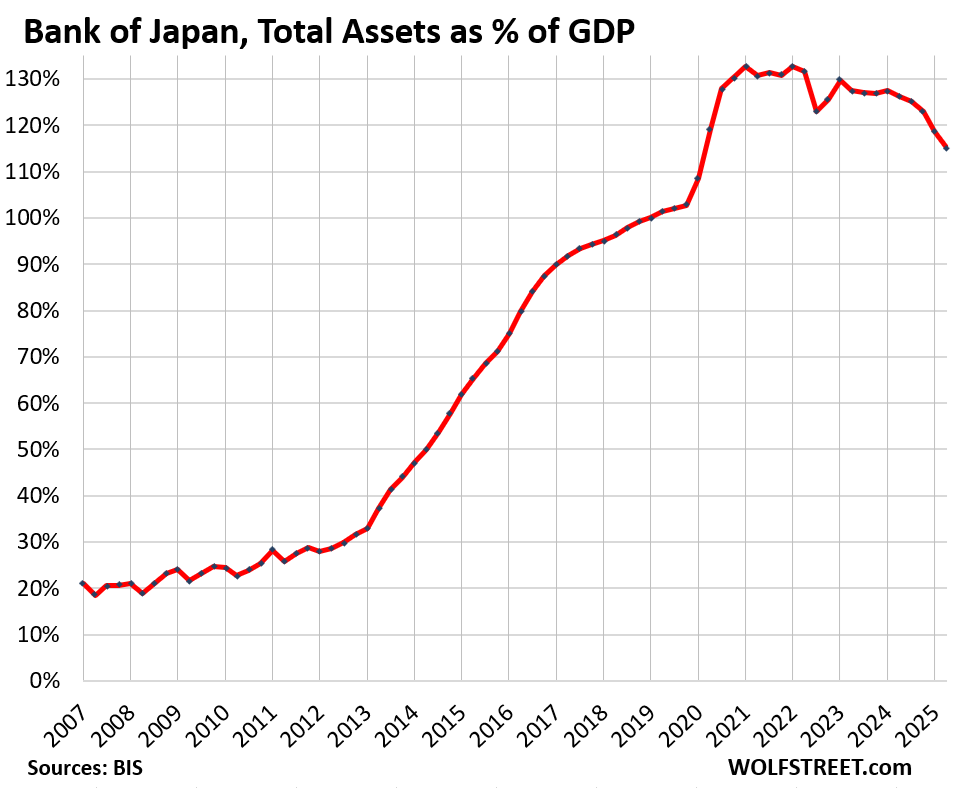
The People’s Bank of China is part of the government, and its Governor is a member of the cabinet. The PBOC has changed a lot over the past 30 years, during which it became an actual central bank. Some of its activities are outside of what normal central banks do, but it has shed many of them, such as by spinning off China’s sovereign wealth fund, which is now the CIC.
The PBOC’s assets-to-GDP ratio has been roughly stable at 33% for the past three years, down by half since 2009, according to BIS data today:
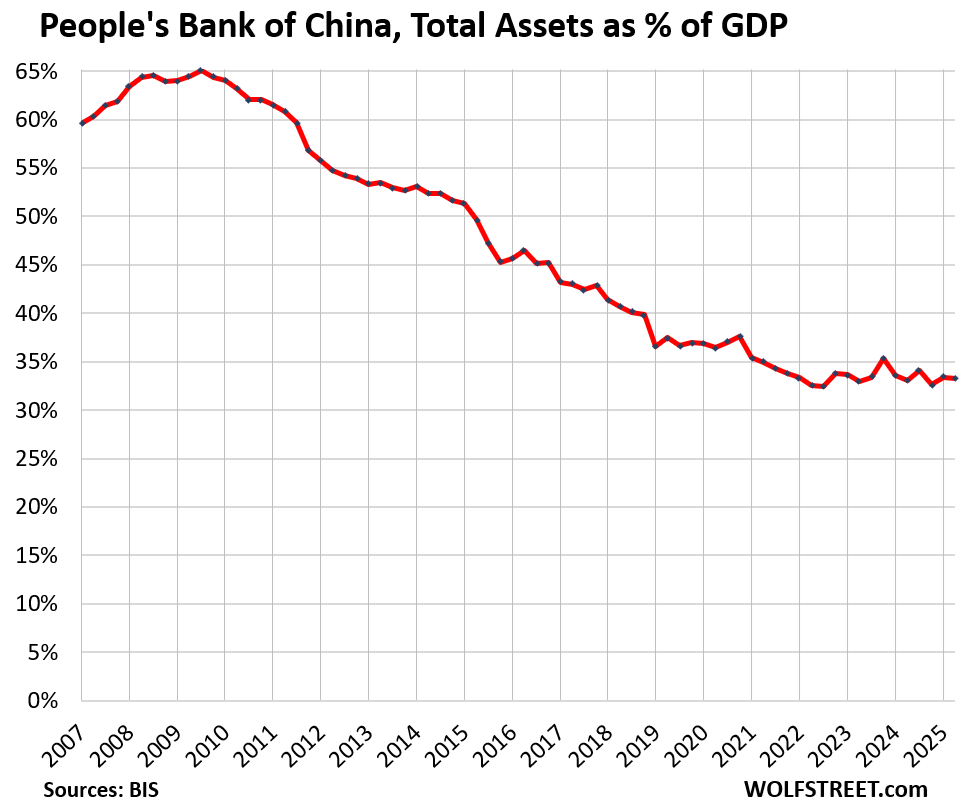
The Bank of Canada maxed out its assets-to-GDP ratio in Q4 2020 at 24.7%, after short but massive QE. It ended QE at relatively low levels and then shed assets fast and furious (details here).
The BOC’s assets-to-GDP ratio has now dropped to 7.8%, according to BIS data today, which is where the Fed was before 2008.
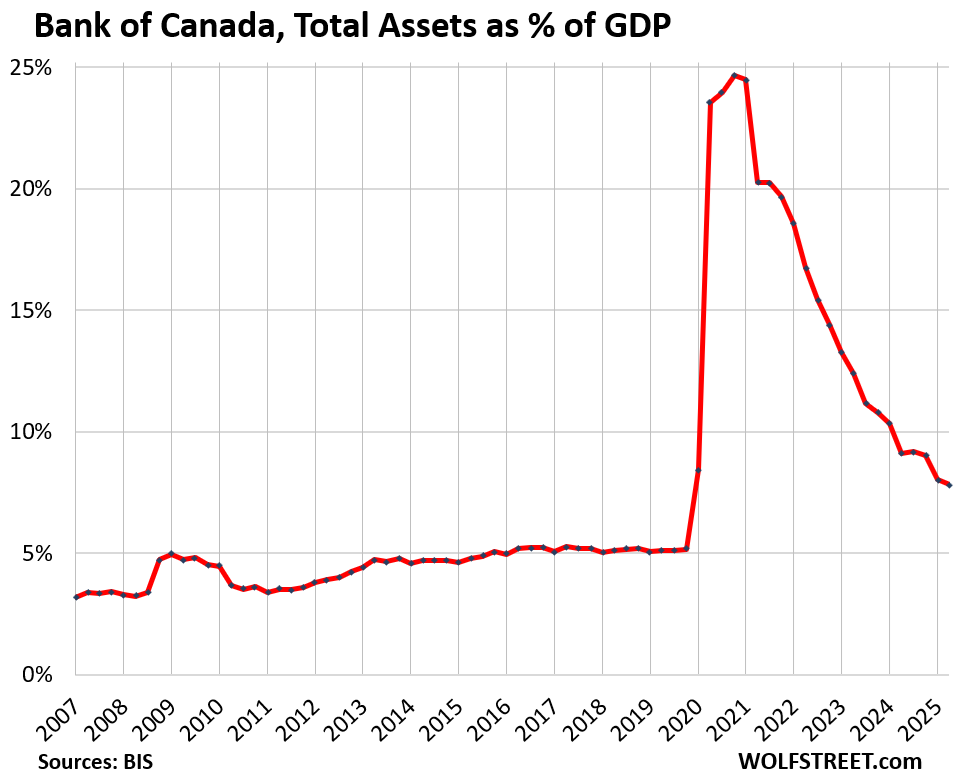
The Bank of England, which loaded up on very long-term bonds with terms out to 2070, has been selling outright its bond holdings. In May this year, the BOE said it would sell all its bonds and address any liquidity issues with repos, which is the classic pre-QE way of balance sheet management.
Its assets-to-GDP ratio had peaked at 49% in Q4 2021, and has now dropped to 28.3%, according to BIS data today:
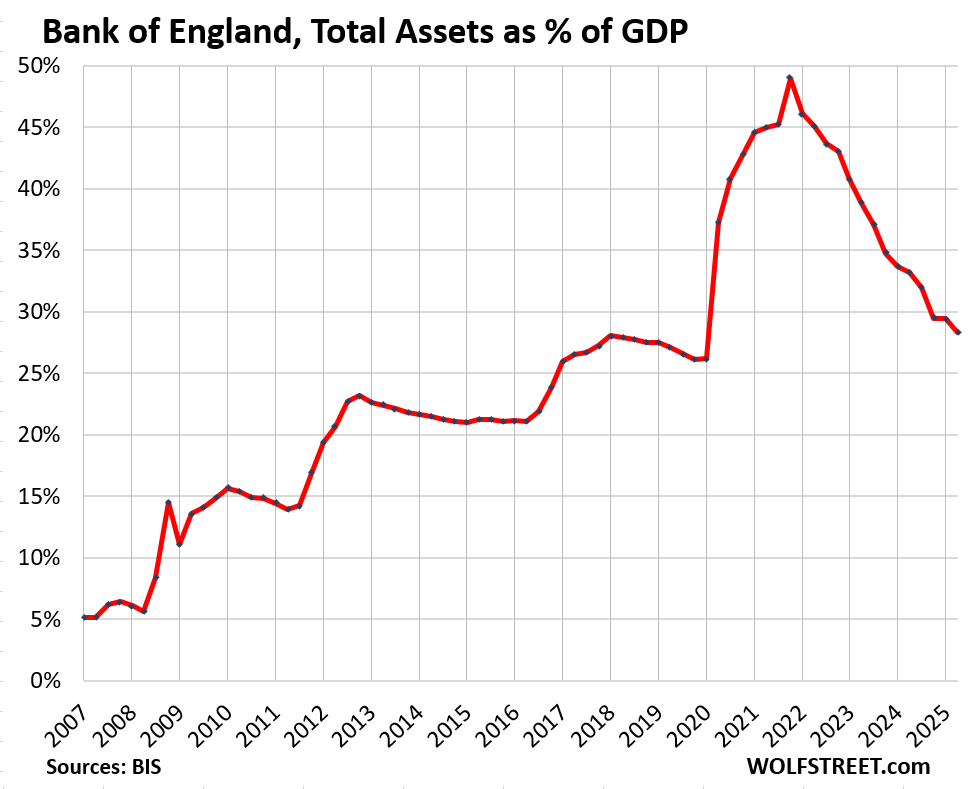
The Reserve Bank of Australia ended QE in 2021 when its assets-to-GDP ratio peaked at 28.6%. The ratio has now dropped to 14.6%:

The Swiss National Bank is onto a different scheme rather than QE. It prints Swiss francs (CHF), but instead of buying CHF-denominated assets, as you’d do for QE, it sells the francs in the foreign exchange markets into ravenous demand, and with the dollars, euros, etc., that it obtains this way, buys assets denominated in those currencies. Under US law, it has to disclose in quarterly SEC filings its holdings of US stocks, so we can follow those. But the details of its other holdings are not disclosed. So this is not really a QE-inflated balance sheet; this is the balance sheet of a hedge fund that can print its own money. It only works as long as there is ravenous demand for Swiss francs.
The asset to GDP ratio has been around 100% for the past two years, down from 145% in Q1 2021:
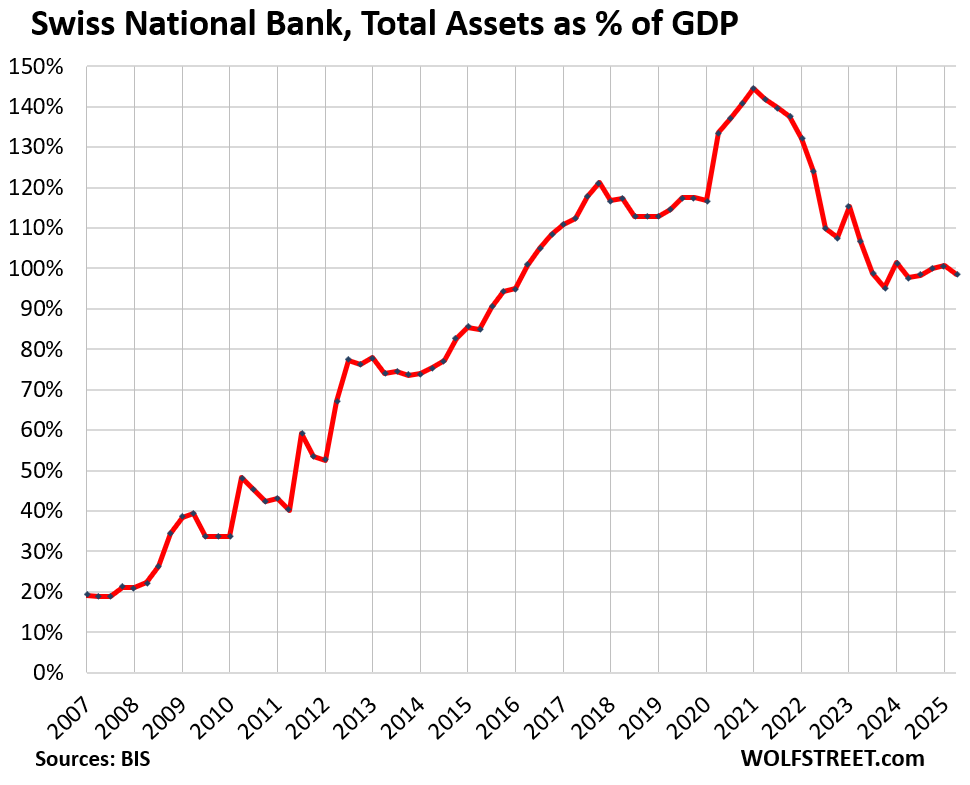
The Central Bank of India, which has to keep an eye on its continuously devaluing currency (against the USD), used QE briefly during the last two crises, but reverted quickly to its relatively high normal assets-to-GDP ratio, which was 23% in the last quarter.

They’re all seeing the same thing: A continued threat of inflation and massive distortions and risks in asset prices, including dangerous housing bubbles that are now deflating in some markets. So they’ve been removing some of the fuel, to walk back from those risks.
Enjoy reading WOLF STREET and want to support it? You can donate. I appreciate it immensely. Click on the mug to find out how:
![]()


Happy Thanksgiving everyone!!!
Happy Thanksgiving Good Sir snd Commentors. 🍻
🙂🦃 🍷 🥳🎈 🍰 😴
.
Thx for finding me and putting me back on the email list.
.